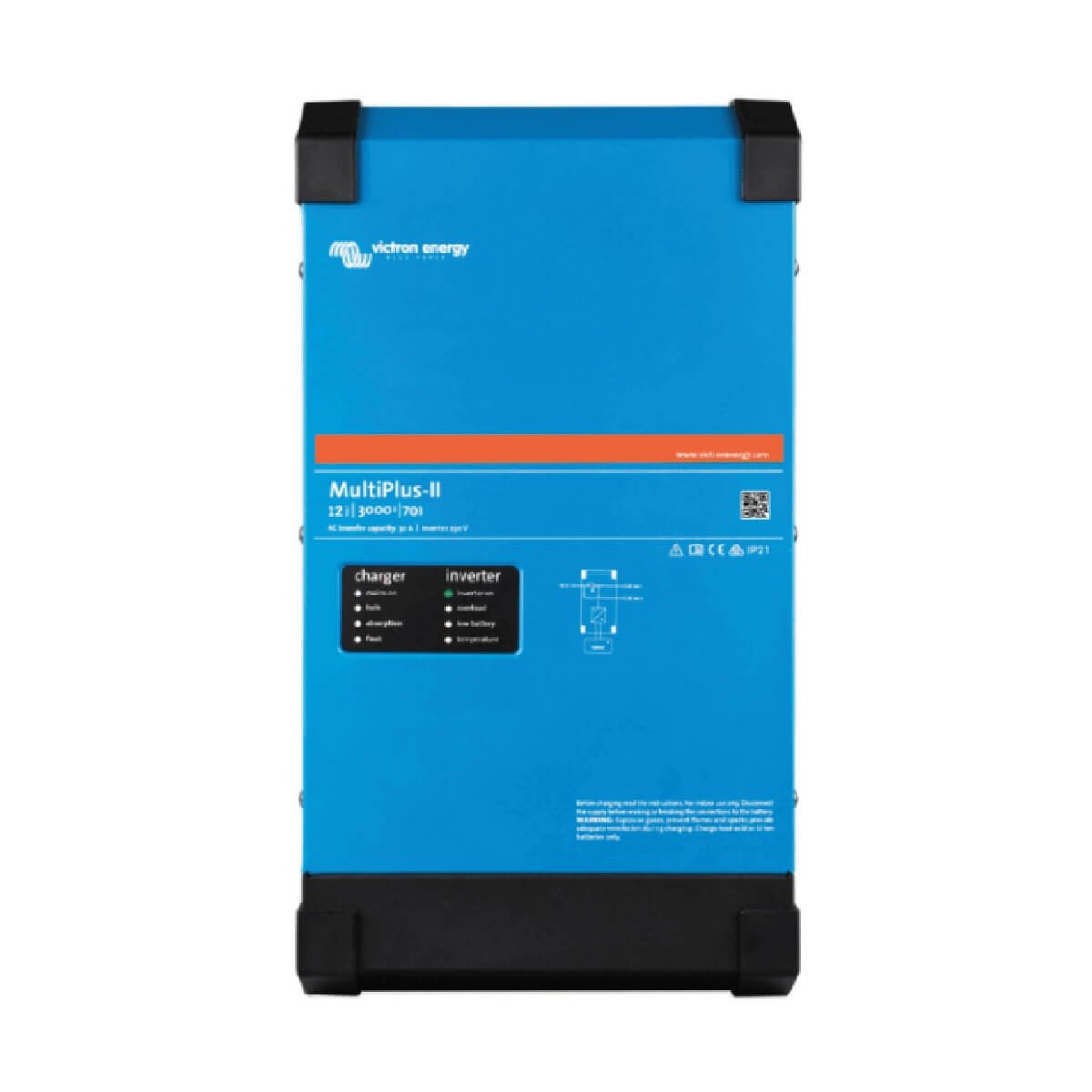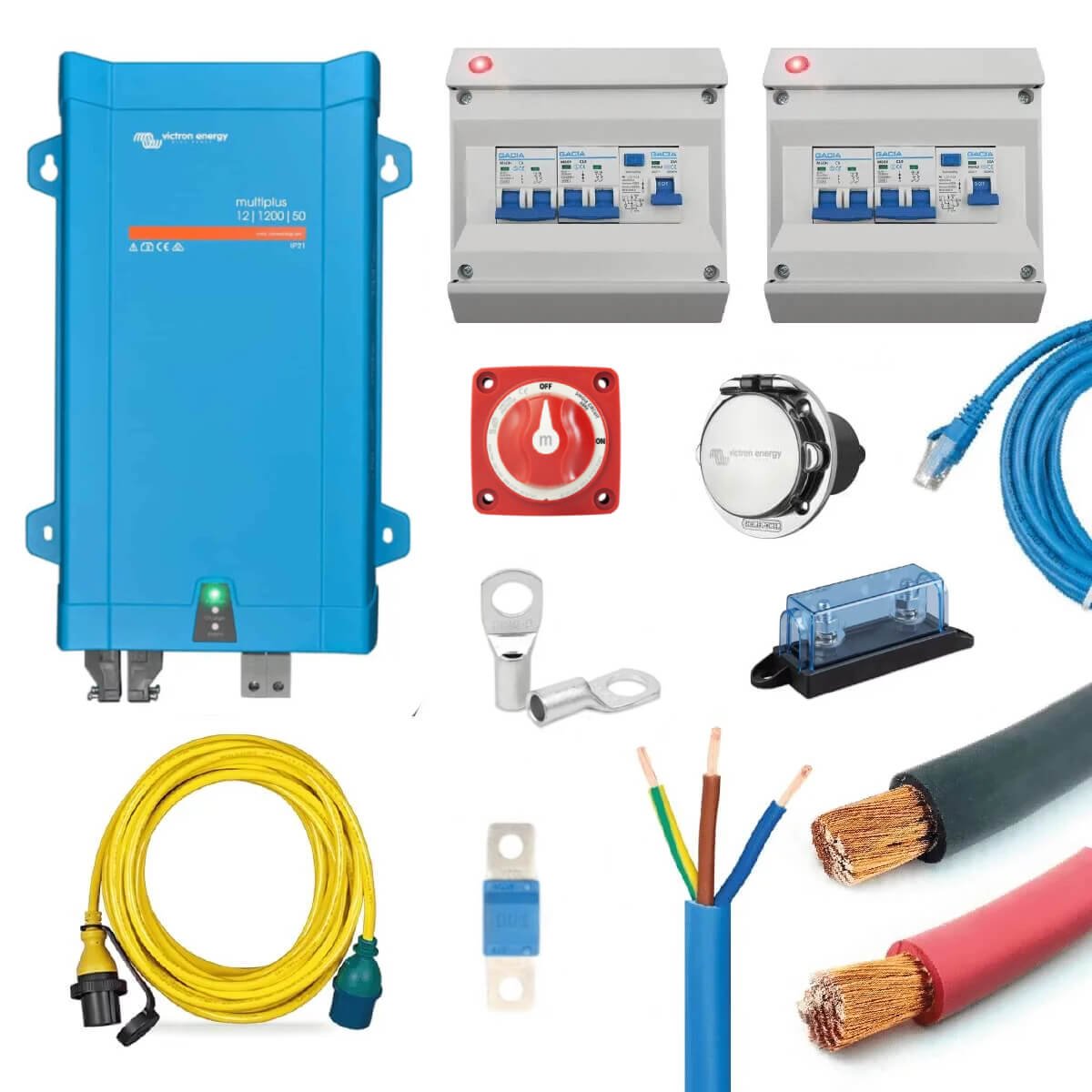Victron MultiPlus
What is the Victron MultiPlus?
The Victron MultiPlus is an inverter charger, which as the name suggests, combines an inverter with a battery charger. An inverter is a device that converts DC power into 230V AC power, which allows you to use mains power appliances off-grid. The battery charger will recharge your leisure batteries via electric hook up. It’s a good idea to install a MultiPlus inverter charger rather than a separate inverter and battery charger, as it reduces installation complexity.
The MultiPlus also contains a transfer switch. This means that when you disconnect from electric hook up, the power source will automatically swap from hook up to your leisure batteries. Without an inverter charger, you would also need to install a switch and manually switch between the battery charger and the inverter each time you moved your campervan.
Which MultiPlus do I need?
The Victron MultiPlus is available in 12V, 24V and 48V models. The 12V model is commonly used in campervan electrical systems as these usually include 12V leisure batteries. However, if you are running a 24V or 48V system, then you will need a Multiplus that uses this voltage. The 12V MultiPlus is available in power ratings from 500VA up to 3000VA. The exact model you require will depend on the appliances you would like to power off-grid. Simply add up the total wattage of each 230V appliance you will use at any one time to calculate the rating you need.
No matter which MultiPlus you install, it’s possible to power up to 3000VA of mains powered appliances when connected to electric hook up. This is because when you are connected to hook up, the MultiPlus bypasses your leisure batteries and inverter and powers your appliances directly from the hook up. This means that if you have certain appliances you will only use when on a campsite (e.g. a hairdryer), you don’t need to factor this into your wattage calculation.
Below you can see the types of appliances you can power off-grid with the range of MultiPluses. This is based on the typical wattage of these appliances (e.g. a hairdryer is ~1600VA) and is assuming only one of these appliances would be used at any one time (e.g. a hairdryer and a microwave can be used with a 1600VA, but not at the same time. To use both of these devices at the same time, you would need a 3000VA MultiPlus).
Most inverter manufacturers use watts (W) to specify inverter power. However, Victron use volt-amperes (VA) instead. VA describes apparent power, whereas W describes real power. The distinction between these can be important when designing your electrical system. To learn more, check out this article, where we discuss the differences between VA and W and how this affects your choice of inverter or inverter/charger.
Recharging your system using electric hook up
The Victron MultiPlus uses an in-built automatic transfer switch to instantaneously switch between shore power and your leisure batteries being the primary power source. Each MultiPlus model provides a different recharging current. This is based on the assumption that users with a smaller MultiPlus, for example the 12/500/20, will likely have a smaller battery bank and won’t need to recharge from shore as quickly. Conversely, the 12/3000/120 MultiPlus can charge at 120A, which would recharge a 300Ah battery bank in just 2.5 hours!
To make sure you choose the right MultiPlus inverter/charger for your needs, you should first consider which power output rating covers your needs when you are off-grid. Next, you will need to check whether that specific MultiPlus model provides a sufficient recharging current to fully recharge your leisure batteries in a sensible amount of time. It’s difficult to quantify a single sensible re-charge time as everybody’s usage is different. You should therefore consider how long you will have access to electric hook up for and how frequently you will be able to use it. You may decide, for example, that the 500VA inverter inside the 12/500/20 MultiPlus is appropriate for your time off-grid. However, if you will only have access to electric hook up for short periods, opting for the 12/800/35 model which can recharge your leisure batteries 60% quicker than the 12/500/20 would be a sensible option.
Model
Recharge current
20A
35A
50A
70A
80A
120A
Hours to recharge a 300Ah leisure battery* via electric hook up
*hours to recharge a 300Ah leisure battery from 10% to 100% (270Ah of usable capacity) via electric hook up
| Model | Recharge current | Hours to recharge a 300Ah leisure battery* via electric hook up |
|---|---|---|
| 12/500/20 MultiPlus | 20A | 13.5hrs |
| 12/800/35 MultiPlus | 35A | 7.7hrs |
| 12/1200/50 MultiPlus | 50A | 5.4hrs |
| 12/1600/70 MultiPlus | 70A | 3.9hrs |
| 12/2000/80 MultiPlus | 80A | 3.4hrs |
| 12/3000/120 MultiPlus-II | 120A | 2.3hrs |
We are often asked, “What is the point of a battery charger that provides more than 16A if an electric hook up point is only rated to 16A?”
It’s important to remember that electric hook up provides power at 230V and 16A which equates to 3680W. The battery charger then converts this power to DC at 12/24/48V to be stored in your leisure batteries. So, if your system is 12V, we can divide the wattage by 12, resulting in a potential to charge at up to 306A. This is why battery chargers typically range from 15-120A in 12V systems.
Victron MultiPlus wiring diagram
This Victron MultiPlus wiring diagram shows how to wire a Victron inverter/charger into a campervan electrical system.
Power coming in via the electric hook up inlet should be connected to the MultiPlus via a consumer unit. Power going out from any 230V loads should be connected via a second consumer unit.
It’s important to include correctly sized MCBs and RCDs in your electrical system to protect against overloads and faults. Check out our article on consumer units for some more guidance on this and consumer unit wiring.
All loads in an electrical system should be connected to the leisure batteries via a positive and negative busbar.
Both the consumer units and the MultiPlus unit should be earthed. You can ground either to the vehicle chassis or via the negative busbar.
All of our MultiPlus kits come with a detailed wiring diagram and installation guide. This explains exactly how to install the specific inverter/charger model. Plus, all kits are provided with all components needed to fully install the MultiPlus as part of your electrical system.










 Wiring diagram included
Wiring diagram included




